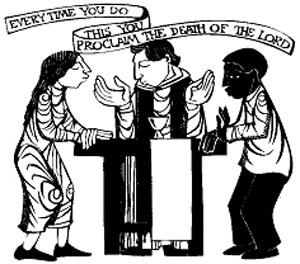Lutherans were once well accustomed to liturgy which was established by statute or decree. Many of the Lutheran Church Orders from the 16th century to the present day were and are established as the forms which must be used and not merely examples or options. Legislated liturgy was imposed not simply because of a need or even a desire to control but because liturgy is inherently confession. Lutherans are not alone here.
The Act of Uniformity of 1549 in England established the same kind of thing there -- what Dix called
“the statutory liturgy,” public worship that had/has the force of law. The Book of Common Prayer was not a suggested pattern which could be followed but the form established by the Church which must be used. Perhaps the situation has changed and enforcement is not what it was, but the rule still stands (even among the options inherent in the current version of the BCP). The prayer book is not only a liturgical document but is also a “constitutional document,”
one of those usages that help to define the way in which this church not
only prays but the way the faith is defined and how it is governed.
Our common prayer (liturgy) is also our common witness. This cannot be simply the definition of the moment or the mass du jour because it confesses. As Lutherans we say this every week (most of us): As often as you eat of this bread and drink of this cup you proclaim the Lord's death until He comes.... Our faithfulness today implies and requires constancy with our past, a resonance with those who went before us and the passing on of the great deposit to those who come after us.
It is this that is behind the greater concern of more uniformity within the established liturgical books and the variety implicit in the forms therein. It is not an attempt to control or to place limits beyond where the Church has always placed those limits -- that which is faithful and that which is not. Liturgy always confesses -- that is not in dispute. What is in dispute is what it will confess and that is shaped and defined by the pattern and the words of the liturgy.
For whatever reason, the situation among American Lutherans has moved from diversity which threatened the Lutheran confession and fractured our unity to the uniformity that sprang from a century of the Common Service now to wide diversity in which what happens on Sunday morning is a battleground among Lutherans. We are not speaking here of the inherent diversity within the published books and forms of the Church (healthy if difficult for some) but the diversity which dispenses with the books and forms entirely. Freedom has become its own license and justification to what is right in the eyes of the moment. But Lutherans were not always this way. Geography brought with it a certain constancy and uniformity. Jurisdictions determined the form and practice of the liturgy in that place and this had the force of confession (at one time a greater authority than even constitution).
Now we struggle to retain not merely the forms but the understanding that liturgy confesses and that confession has the force of, no, a greater force than constitution. Before anything else, liturgy confesses but it also shapes and defines how the Church is governed and what the Church does. Until we recapture this sense of confession, we will only do battle with one side or the other gaining and losing while we have lost sight of what the war is over. It is not over a page number or a book but for what we confess and how we live. The shape of these questions and their answers is and must always be liturgical.

2 comments:
Thoughtful post, Pr. Peters. On an less-than-pious note, the clip art reminds me of Family Feud.
Pr. Beck, I thought the same thing. I'm glad I'm not the only one.
Post a Comment